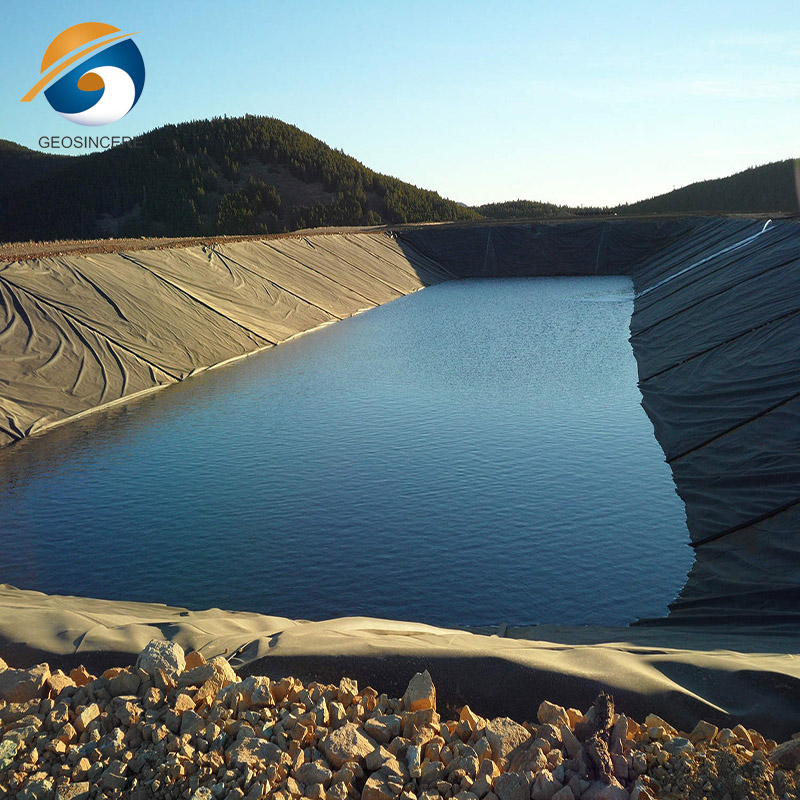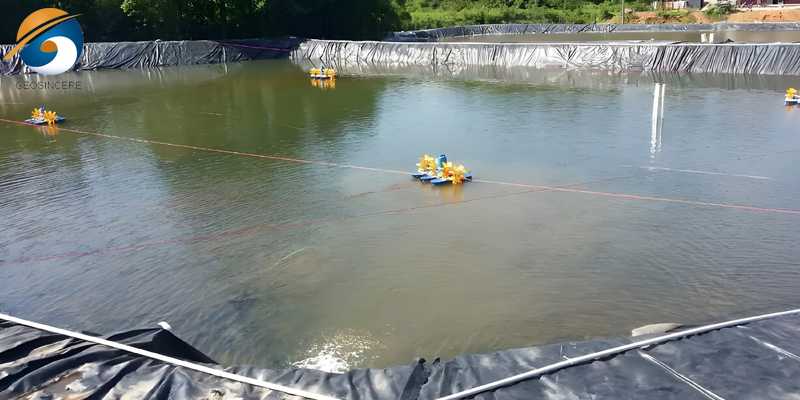LLDPE Geomembrane Pond Liner 500 micron Price
LLDPE (linear low-density polyethylene) Geomembrane Pond Liner is a widely used anti-seepage material in water tanks, dams, and other bodies of water, with a thickness of 500 microns. This material has excellent flexibility and durability, and can effectively resist the effects of ultraviolet radiation, chemicals, and temperature changes. The production process of LLDPE geomembrane pond liner ensures its uniform thickness and high strength, enabling it to maintain good performance under various environmental conditions. In addition, the low permeability of LLDPE geomembrane pond liner can effectively prevent water loss, ensure water quality and quantity, and is widely used in fields such as agricultural irrigation, environmental engineering, and water resource management. It is easy to install and has low maintenance costs, making it an important choice for modern water management.
Linear Low-Density Polyethylene (LLDPE) geomembrane pond liners are widely used in environmental containment projects due to their flexibility, chemical resistance, and cost-effectiveness. The 500 micron LLDPE geomembrane variant is particularly favored for medium to large-scale ponds, irrigation systems, mining tailings, and aquaculture applications. This article offers a technical breakdown of the pricing structure of 500 micron LLDPE geomembrane pond liners, including influencing factors, applicable standards, and important considerations.
What Is a 500 Micron LLDPE Geomembrane Pond Liner?
A 500 micron LLDPE liner is a geomembrane sheet with a thickness of 0.5 mm, engineered to offer a balance between durability and cost. It is primarily used for lining ponds, canals, waste storage, and other fluid containment areas.
Key Characteristics:
Material: Linear Low-Density Polyethylene
Thickness: 0.5 mm (500 microns)
Tensile Strength: ≥16 MPa
Elongation at Break: ≥600%
Puncture Resistance: High due to molecular flexibility
UV Resistance: Moderate, depending on carbon black content
Average Price of 500 Micron LLDPE Geomembrane (as of 2025)
Prices can vary significantly depending on quantity, region, quality certification, and delivery terms. However, as a general guide:
Per Square Meter: USD $0.40 – $0.75
Per Roll (Width 5.8m x Length 100m = 580 m²): USD $230 – $435
Per Metric Ton (Approx. 2,000–2,200 m²): USD $820 – $1,300
Note: Prices fluctuate based on resin costs, freight charges, and compliance standards.
Factors Influencing LLDPE Geomembrane Liner Price
Raw Material Quality
Virgin vs recycled polyethylene
Additive concentration (UV stabilizers, antioxidants)
Certifications & Compliance
ASTM D5885, GRI GM17, ISO 9001 production standards
Regulatory demands (especially for municipal or hazardous waste containment)
Manufacturing Technology
Blow film extrusion vs calendaring
Double-sided texturing or smooth finish
Logistics & Transportation
Container loading volume (lightweight material but bulky)
Freight costs for overseas delivery
Installation Accessories
Seaming equipment and geomembrane welding tapes
Anchor trenches and protective geotextiles
Engineering and Regulatory Considerations
Applicable Engineering Standards:
GRI-GM17: Standard specification for LLDPE geomembranes
ASTM D5199: Thickness determination
ASTM D638: Tensile properties
ASTM D4833: Puncture resistance
Environmental Regulations:
EPA Title 40 CFR Part 258: Requirements for liners in landfills and wastewater facilities
FAO Aquaculture Guidelines: Standards for safe use in fish farming
Design Principles:
Minimum slope of 3:1 for surface runoff
Weld strength ≥80% of parent material
Allowance for thermal expansion/contraction (up to 3%)
Example: Cost Breakdown for a 1,000 m² Pond
| Item | Specification | Cost Estimate (USD) |
|---|---|---|
| LLDPE Liner | 500 micron | $450 – $750 |
| Seaming & Welding | Hot wedge welding | $120 – $180 |
| Geotextile Protection | 200 gsm | $90 – $140 |
| Installation Labor | Skilled crew | $300 – $500 |
| Total | - | $960 – $1,570 |
FAQs on 500 Micron LLDPE Geomembrane Liners
Q1: Is 500 micron LLDPE suitable for fish ponds?
A: Yes, provided the material is food-grade and free from toxic additives. UV-stabilized variants are preferred for outdoor exposure.
Q2: Can 500 micron liners be used for hazardous waste?
A: No. For hazardous applications, thicker geomembranes (e.g., 1.5 mm HDPE) are required under EPA guidelines.
Q3: How long does a 500 micron LLDPE liner last?
A: In buried conditions, up to 20 years. In exposed environments, lifespan drops to 5–10 years without UV stabilization.
Q4: What is the difference between LLDPE and HDPE liners?
A: LLDPE is more flexible and has better elongation, making it suitable for uneven substrates. HDPE is more rigid and chemically resistant.
Q5: Can it be repaired on-site?
A: Yes, using hot-air or extrusion welding equipment, though professional repair is advised to maintain waterproof integrity.
Installation Tips
Store the liner in shaded conditions before use to avoid premature UV degradation.
Ensure surface is free of sharp objects, debris, and vegetation.
Allow for thermal expansion during welding (especially in hot climates).
Use a minimum overlap of 10 cm for seaming.
Avoid installation during windy or rainy conditions.
Final Thoughts and Professional Recommendation
The 500 micron LLDPE geomembrane pond liner represents a cost-effective solution for a range of water containment projects. While pricing varies based on location, volume, and quality specifications, the liner remains an accessible and flexible choice for agriculture, aquaculture, and municipal water storage applications.
For project planners, engineers, or procurement specialists, careful attention to material standards, certification, and installation methodology is critical to ensuring the long-term success of any geomembrane deployment.
Call to Action
Looking to source high-quality, certified 500 micron LLDPE geomembrane pond liners for your next project? We offer technical consultations, specification reviews, and quantity-based quotations to ensure optimal performance and compliance. Contact us now with your project requirements, and our engineering support team will assist you in selecting the most suitable liner solution.












